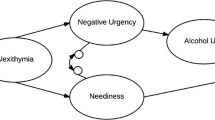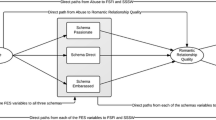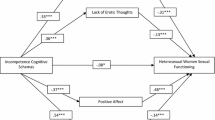Abstract
Women with a history of childhood sexual abuse (CSA) are at greater risk for experiencing sexual problems in their adult lives. Yet, little is known about the possible role of cognitive and affective mechanisms in the development of sexual arousal difficulties in this population. This study investigated the role of pre-existing affect (affect prior to exposure to sexual stimuli) on genital responses, subjective sexual arousal, and affect elicited during the presentation of erotic film excerpts in a community sample of 25 women with and 25 women without a history of CSA. The CSA group showed greater pre-existing negative affect and smaller genital responses to the erotic film stimuli compared to the NSA group. Findings support a moderating effect of CSA, in that pre-existing negative affect was associated with strength of genital responses in the NSA but not in the CSA group. The results did not support a mediation model of pre-existing negative affect as an explanation for smaller physiological sexual responses in the CSA group. Taken together, the findings suggest that pre-existing affect may be more relevant for women with no history of CSA and call for more research on factors implicated in impaired sexual responses in women with a history of CSA.


Similar content being viewed by others
References
Bancroft, J., Janssen, E., Strong, D., Carnes, L., Vukadinovic, Z., & Long, J. S. (2003). The relation between mood and sexuality in heterosexual men. Archives of Sexual Behavior, 32, 217–230.
Barlow, D. H. (1986). The causes of sexual dysfunction: The role of anxiety and cognitive interference. Journal of Consulting and Clinical Psychology, 54, 140–148.
Barlow, D. H., Sakheim, D. K., & Beck, J. G. (1983). Anxiety increases sexual arousal. Journal of Abnormal Psychology, 92, 49–54.
Baron, R. M., & Kenny, D. A. (1986). The moderator-mediator variable distinction in social psychological research: Conceptual, strategic and statistical considerations. Journal of Personality and Social Psychology, 51, 1173–1182.
Beggs, V. E., Calhoun, K. S., & Wolchik, S. A. (1987). Sexual anxiety and female sexual arousal: A comparison of arousal during sexual anxiety stimuli and sexual pleasure stimuli. Archives of Sexual Behavior, 16, 311–319.
Bornovalova, M. A., Gwadz, M. A., Kahler, C., Aklin, W. M., & Lejuez, C. W. (2008). Sensation seeking and risk-taking propensity as mediators in the relationship between childhood abuse and HIV-related risk behavior. Child Abuse and Neglect, 32, 99–109.
Bradford, A., & Meston, C. M. (2006). The impact of anxiety on sexual arousal in women. Behaviour Research and Therapy, 44, 1067–1077.
Brodsky, B. S., Oquendo, M., Ellis, S. P., Haas, G. L., Malone, K. M., & Mann, J. J. (2001). The relationship of childhood abuse to impulsivity and suicidal behavior in adults with major depression. American Journal of Psychiatry, 158, 1871–1877.
Browning, C. R., & Laumann, E. O. (1997). Sexual contact between children and adults: A life course perspective. American Sociological Review, 62, 540–560.
Chorpita, B. F., & Barlow, D. H. (1998). The development of anxiety: The role of control in the early environment. Psychological Bulletin, 124, 3–21.
Delizonna, L. L., Wincze, J. P., Litz, B., Brown, T. A., & Barlow, D. B. (2000). Subjective and physiological arousal compared in erotically and mechanically attained erections. Journal of Sex and Marital Therapy, 27, 21–31.
DiLillo, D. (2001). Interpersonal functioning among women reporting a history of child sexual abuse: Empirical findings and methodological issues. Clinical Psychology Review, 21, 553–576.
Elliot, A. N., & O’Donohue, W. T. (1997). The effects of anxiety and distraction on sexual arousal in a nonclinical sample of heterosexual women. Archives of Sexual Behavior, 26, 607–624.
Ellis, E. M., Atkeson, B. M., & Calhoun, K. S. (1981). An assessment of long-term reaction to rape. Journal of Abnormal Psychology, 90, 263–266.
Finkelhor, D. (1979). Sexually victimized children. New York: Free Press.
Finkelhor, D., Hotaling, G. T., Lewis, I. A., & Smith, C. (1989). Sexual abuse and its relationship to later sexual satisfaction, marital status, religion, and attitude. Journal of Interpersonal Violence, 4, 379–399.
Heiman, J. R. (1980). Female sexual response patterns: Interactions of physiological, affective, and contextual cues. Archives of General Psychiatry, 37, 1311–1316.
Heiman, J., & Rowland, D. (1983). Affective and physiological sexual response patterns: The effects of instruction on sexually functional and dysfunctional men. Journal of Psychosomatic Research, 27, 105–116.
Hoon, P. W., Wincze, J. P., & Hoon, E. F. (1977). A test of reciprocal inhibition: Are anxiety and sexual arousal in women mutually inhibitory? Journal of Abnormal Psychology, 86, 65–74.
Janssen, E., & Bancroft, J. (2007). The dual-control model: The role of sexual inhibition and excitation in sexual arousal and behavior. In E. Janssen (Ed.), The psychophysiology of sex (pp. 197–222). Bloomington, IN: Indiana University Press.
Kline, P. (1994). Factor analysis in test construction. In P. Kline (Ed.), An easy guide to factor analysis (pp. 125–139). London: Routledge Press.
Laan, E., & Everaerd, W. (1995). Determinants of female sexual arousal: Psychophysiological theory and data. Annual Review of Sex Research, 6, 32–76.
Laan, E., & Everaerd, W. (1998). Physiological measures of vasocongestion. International Journal of Impotence Research, 10, 107–110.
Laan, E., Everaerd, W., van Bellen, G., & Hanewald, G. (1994). Women’s emotional responses to male- and female-produced erotica. Archives of Sexual Behavior, 23, 153–169.
Laan, E., Everaerd, W., Van-Aanhold, M., & Rebel, M. (1993). Performance demand and sexual arousal in women. Behaviour Research and Therapy, 31, 25–35.
Leonard, L. M., & Follette, V. M. (2002). Sexual functioning in women reporting a history of child sexual abuse: Review of the empirical literature and clinical implications. Annual Review of Sex Research, 13, 346–388.
Lykins, A., Janssen, E., & Graham, C. A. (2006). The relationship between negative mood and sexuality in heterosexual college women. Journal of Sex Research, 43, 136–143.
McCall, K., & Meston, C. M. (2007). The effects of false positive and false negative physiological feedback on sexual arousal: A comparison of women with or without sexual arousal disorder. Archives of Sexual Behavior, 36, 518–530.
Meston, C. M., & Heiman, J. R. (2000). Sexual abuse and sexual function: An examination of sexually relevant cognitive processes. Journal of Consulting and Clinical Psychology, 68, 399–406.
Meston, C. M., Rellini, A. H., & Heiman, J. R. (2006). Women’s history of sexual abuse, their sexuality, and sexual self-schemas. Journal of Consulting and Clinical Psychology, 74, 229–236.
Mullen, P. E., Martin, J. L., Anderson, J. C., Romans, S. E., & Herbison, G. P. (1994). The effect of child sexual abuse on social, interpersonal and sexual function in adult life. British Journal of Psychiatry, 165, 35–47.
Murphy, S. T., Monahan, J. L., & Zajonc, R. B. (1995). Additivity of nonconscious affect: Combined effects of priming and exposure. Journal of Personality and Social Psychology, 69, 589–602.
Neumann, R., Seibt, B., & Strack, F. (2001). The influence of global mood on emotions: Disentangling feeling and knowing. Cognition and Emotion, 15, 725–747.
NIMH Multisite HIV Prevention Trial Group. (2001). A test of factors mediating the relationship between unwanted sexual activity during childhood and risky sexual practices among women enrolled in the NIMH Multisite HIV Prevention Trial. Women and Health, 33, 163–180.
Nobre, P. J., & Pinto-Gouveia, J. (2008). Differences in automatic thoughts presented during sexual activity between sexually functional and dysfunctional men and women. Cognitive Therapy and Research, 32, 37–49.
Palace, E. M., & Gorzalka, B. B. (1990). The enhancing effects of anxiety on arousal in sexually dysfunctional and functional women. Journal of Abnormal Psychology, 99, 403–411.
Peterson, Z., & Janssen, E. (2007). Ambivalent affect and sexual response: The impact of co-occurring positive and negative emotions on subjective and physiological sexual responses to erotic stimuli. Archives of Sexual Behavior, 36, 793–807.
Polka, D. E., Cohena, S., Doyleb, W. J., Skonerc, D. P., & Kirschbaumd, C. (2005). State and trait affect as predictors of salivary cortisol in healthy adults. Psychoneuroendocrinology, 30, 261–272.
Prause, N., & Janssen, E. (2006). Blood flow: Vaginal photoplethysmography. In I. Goldstein, C. Meston, S. Davis, & A. Traish (Eds.), Women’s sexual function and dysfunction: Study, diagnosis, and treatment (pp. 359–367). New York: Taylor & Francis.
Rellini, A. H. (2008). Review of the empirical evidence for a theoretical model to understand the sexual problems of women with a history of CSA. Journal of Sexual Medicine, 5, 31–46.
Rellini, A. H., & Meston, C. M. (2006). Psychophysiological sexual arousal in women with a history of childhood sexual abuse. Journal of Sex and Marital Therapy, 32, 5–22.
Rellini, A. H., & Meston, C. M. (2007a). Sexual desire and linguistic analysis: A comparison of sexually abused and non-abused women. Archives of Sexual Behavior, 36, 67–77.
Rellini, A. H., & Meston, C. M. (2007b). Sexual function and satisfaction in adults based on the definition of child sexual abuse. Journal of Sexual Medicine, 4, 1312–1321.
Schacht, R. L., George, W. H., Heiman, J. R., Davis, K. C., Norris, J., Stoner, S. A., et al. (2007). Effects of alcohol intoxication and instructional set on women’s sexual arousal vary based on sexual abuse history. Archives of Sexual Behavior, 38, 498–513.
ter Kuile, M. M., Vigeveno, D., & Laan, E. (2007). Preliminary evidence that acute and chronic daily psychological stress affect sexual arousal in sexually functional women. Behaviour Research and Therapy, 45, 2078–2089.
Watson, D., & Clark, L. A. (1984). Negative affectivity: The disposition to experience aversive emotional states. Psychological Bulletin, 96, 465–490.
Watson, D., Clark, L. A., & Tellegen, A. (1988). Development and validation of brief measures of positive and negative affect: The PANAS scales. Journal of Personality and Social Psychology, 54, 1063–1070.
Watson, D., & Tellegen, A. (1985). Toward a consensual structure of mood. Psychological Bulletin, 98, 219–235.
Yehuda, R. (2003). Adult neuroendocrine aspects of PTSD. Psychiatric Annals, 33, 30–36.
Acknowledgments
This research was supported, in part, by Grant Number R01 HD51676 from the National Institute for Child Health and Human Development to Cindy M. Meston and by the training Grant Number F31 MH68165 from the National Institute of Mental Health to Alessandra Rellini and Cindy Meston, and by the McNeil Prevention and Community Psychology Fund to Alessandra Rellini. The contents of this article are solely the responsibility of the authors and do not represent the official views of the National Institute of Child Health and Human Development or the National Institute of Mental Health. The authors would like to thank Dr. Dianna Murray-Close and Dr. Keith Burt for their statistical consultation, and Carolyn Dundon, Saiful Islam, and Sarah Roberts for their contribution to data collection and data processing.
Author information
Authors and Affiliations
Corresponding author
Rights and permissions
About this article
Cite this article
Rellini, A.H., Elinson, S., Janssen, E. et al. The Effect of Pre-Existing Affect on the Sexual Responses of Women With and Without a History of Childhood Sexual Abuse. Arch Sex Behav 41, 329–339 (2012). https://doi.org/10.1007/s10508-011-9772-y
Received:
Revised:
Accepted:
Published:
Issue Date:
DOI: https://doi.org/10.1007/s10508-011-9772-y




